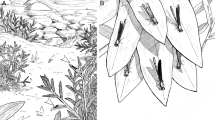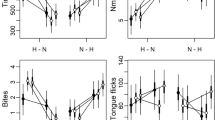Summary
Territorial male yellow-headed blackbirds that were dyed solid black were similar to controls in their ability to attract mates. They also had no difficulty in defending their territories from floating males. The only remarkable effect of this dramatic color manipulation was that five of the 12 blackened males that regained a territory after being dyed also later took over the better quality territory of another male. Not one of the 11 control males that regained a territory succeeded in such an eviction. This surprising result is interpretable under the theory that conspicuous and distinctive coloration sometimes evolves as an arbitrary recognition badge by making good fighters more memorable to their opponents. With insight gained from these results, we modify and considerably expand the theoretical treatment of this Arbitrary Identity Badge Hypothesis. We also explain why our results for yellow-headed blackbrids should differ so dramatically from those for red-winged blackbirds where blackened males often lost their territories to floating males.
Similar content being viewed by others
References
Butcher GS (1984) Sexual color dimorphism in orioles (the genus Icterus): tests of communication hypotheses. PhD dissertation, University of Washington
Butcher GS, Rohwer S (1989) The evolution of conspicuous and distinctive coloration for communication in birds. Current Ornithol 6:51–108
Collias EC, Collias NE, Jacobs CH, McAlary F, Fujimoto JT (1979) Experimental evidence for facilitation of pair formation by bright color in weaverbirds. Condor 81:91–93
Davies NB, Houston AI (1981) Owners and satellites: the economics of territory defense in the pied wagtail, Motacilla alba. J Anim Ecol 50:157–180
Hansen AJ, Rohwer S (1986) Coverable badges and resource defense in birds. Anim Behav 34:69–76
Krebs JR (1982) Territorial defense in the great tit (Parus major): Do residents always win? Behav Ecol Sociobiol 11:185–194
Lewis DM (1972) Importance of face mask in sexual recognition and territorial behavior in the Yellowthroat. Jack-Pine Warbler 50(4):98–109
Orians GH, Christman GM (1968) A comparative study of the behavior of red-winged, tricolored, and yellow-headed blackbirds. Univ Calif Publs Zool 84:1–81
Peek FW (1972) An experimental study of the territorial function of vocal and visual displays in the male red-winged blackbird (Agelaius phoeniceus). Anim Behav 20:112–178
Remsen JV Jr (1984) High incidence of “leapfrog” pattern of geographic variation in Andean birds: implications for the speciation process. Science 224:171–173
Rohwer S (1977) Status signaling in Harris' sparrows: some experiments in deception. Behav 61:107–129
Rohwer S (1982) The evolution of reliable and unreliable badges of fighting ability. Am Zool 22:531–546
Rohwer S (1985) Dyed birds achieve higher social status than controls in Harris' sparrows. Anim Behav 33:1325–1331
Rohwer S, Ewald PW (1981) The cost of dominance and advantage of subordination in a badge signaling system. Evol 35:441–454
Rohwer S, Fretwell SD, Niles DM (1980) Delayed maturation in passerine plumages and the deceptive acquisition of resources. Am Nat 115:400–437
Rohwer S, Rohwer FC (1978) Status signaling in Harris' sparrows: experimental deceptions achieved. Anim Behav 26:1012–1022
Røskaft E, Rohwer S (1987) An experimental study of the red epaulettes and the black body colour of male red-winged blackbirds. Anim Behav 35:1070–1077
Rutberg AT, Rohwer S (1980) Breeding strategies of male yellow-headed blackbirds: results of a removal experiment. Auk 97:619–622
Slagsvold T, Lifjeld JT (1988) Plumage colour and sexual selection in the pied flycatcher Ficedula hypoleuca. Anim Behav 36:395–407
Smith DG (1972) The role of the epaulets in the redwinged blackbird (Agelaius phoeniceus) social system. Behaviour 41:251–268
West-Eberhard MJ (1983) Sexual selection, social competition, and speciation. Quart Rev Biol 58:155–183
Yasukawa K (1979) Territory establishment in Red-winged Blackbirds: importance of aggressive behavior and experience. Condor 81:258–264
Author information
Authors and Affiliations
Rights and permissions
About this article
Cite this article
Rohwer, S., Røskaft, E. Results of dyeing male yellow-headed blackbirds solid black: implications for the arbitrary identity badge hypothesis. Behav Ecol Sociobiol 25, 39–48 (1989). https://doi.org/10.1007/BF00299709
Received:
Accepted:
Issue Date:
DOI: https://doi.org/10.1007/BF00299709




